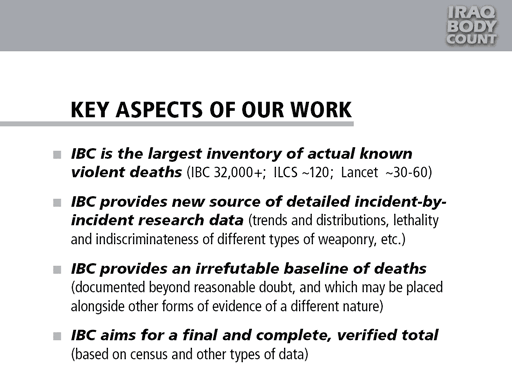In early 2006 IBC was invited to introduce its work at a Working Group Meeting on methods used by researchers to estimate armed conflict deaths (organised by the Small Arms Survey, Geneva, 17 Feb 2006).
Well-received by experts at the meeting, On Iraq Body Count summarised the project’s key features and innovations.
Key aspects of our work
-
IBC is the largest inventory of actual known violent deaths
(IBC 32,000+; ILCS ˜120; Lancet ˜30-60) -
IBC provides a new source of detailed incident-by-incident research data
(trends and distributions, lethality and indiscriminateness of different types of weaponry, etc.) -
IBC provides an irrefutable baseline of deaths
(documented beyond reasonable doubt, and which may be placed alongside other froms of evidence of a different nature) -
IBC aims for a final and complete, verified total
(based on census and other trypes of data)
6.0 Key aspects of our work
What unites the foregoing criticisms is a narrow focus on the total number of deaths. These entirely miss four key aspects of our work.
The ILCS interviewed Iraqis during the Spring of 2004 and published its findings on the web in 2005. Commissioned by the UNDP, this household survey covered many other factors affecting Iraqi welfare in addition to mortality. Its estimates for war-related violent deaths are on page 54 of Volume II: Analytical Report (PDF).
-
We have by far the largest inventory outside Iraq of actual known deaths: our method has allowed us to obtain detailed information on over 30,000 individual deaths and their circumstances. Assuming even the most pessimistic outturn for violent civilian deaths, our database must include a substantial proportion of all victims, certainly not less than 25%, probably significantly more than half. In contrast, the Iraq Living Conditions Survey (ILCS), commissioned by the United Nations Development Programme (UNDP), has obtained direct information on only around 120 deaths, civilian and military, representing about 0.5% of their central estimate of 24,000 deaths. However, at around one in 200 people sampled, ILCS remains by far the largest survey incorporating the most representative sample so far conducted in post-invasion Iraq.
The Les Roberts et al. survey published in Lancet documented just over 30 "excess" post-invasion deaths from a much smaller sample, in which about 20 deaths were violent (or ~60 violent deaths if the statistical outlier of their survey - a Fallujah neighbourhood - is included). These ~30 deaths represent 0.03%, or one in 3,000, of their central estimate of 98,000 deaths. Lancet provides a timeline for its recorded deaths. Just five of the deaths recorded by Roberts et al. were caused during the entire "Shock and Awe" invasion phase, four of them occurring in March 2003 and one in April 2003. Therefore any detailed knowledge of Iraqi deaths - civilian or military - caused by the intense air- and ground-war that prevailed in this period based solely on Lancet would have to be derived from no more than five individuals killed. IBC has recorded some 7,300 civilian deaths during the invasion phase at varying levels of detail.
-
Our main long-term academic value may well turn out to be the demonstration of the possibility of using media reports to provide a completely new source of detailed incident-by-incident data - of a type not available in any previous war - which allows assessment of trends and distributions, lethality and indiscriminateness of different types of weaponry, and many other patterns that have, up till now, remained inaccessible to researchers.
-
Our data provide an irrefutable baseline of deaths which are documented beyond reasonable doubt, and which may be placed alongside other forms of evidence of a different nature.
-
The open-ended nature of the project makes it a feasible (if long term) goal to provide a final and complete number based on census and other types of data.

